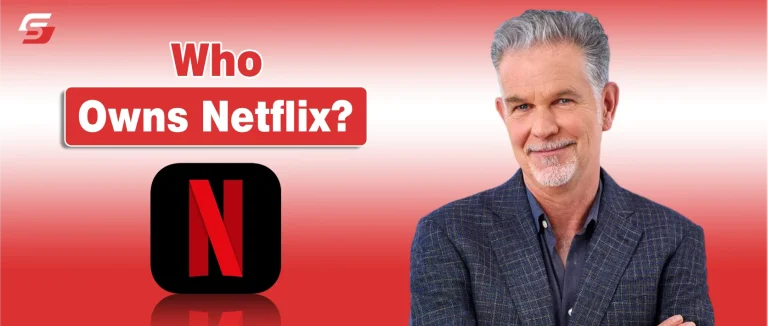Netflix is a publicly owned company, not an individually owned platform, and its control is divided between founders, executives, and major shareholders. Most people searching for “who owns Netflix” want a clear explanation of who holds real authority, how much stake the founders still control, and whether any tech giant like Disney, Amazon, or Apple owns a portion of it.
In this guide, we break down the current ownership structure, including Reed Hastings’ remaining stake, the roles of Ted Sarandos and Greg Peters, the influence of institutional investors, and the independent leadership model that shapes Netflix’s strategy. By the end, you’ll know exactly who owns Netflix today and who makes the decisions behind the world’s largest streaming service.
Netflix Founders and the Origin of Ownership
Netflix began as a small California-based startup shaped by two founders whose decisions influenced the company’s earliest ownership structure. Netflix started as a DVD-by-mail service, and its founders held full control before outside financing began to shape ownership distribution.
This section explains how Reed Hastings and Marc Randolph built the company, how their share distribution began, and how early ownership transitioned during Netflix’s growth into a global streaming platform.
Reed Hastings’ Early Ownership and Role
Reed Hastings played the central role in defining Netflix’s initial ownership and leadership direction. Reed Hastings provided the majority of the seed funding, which gave him the largest early ownership stake. Reed Hastings also served as the first CEO, which made him responsible for strategy, company structure, and early operations during the DVD-by-mail era.
Key attributes of Reed Hastings’ early role:
- Reed Hastings acted as chief decision maker during Netflix’s launch phase.
- Reed Hastings held the largest founder stake because he financed the company’s initial development.
- Reed Hastings guided the shift to online streaming, which changed the ownership needs of the business as new investment entered.
Reed Hastings’ early ownership gradually diluted when Netflix raised capital, issued stock options, and prepared for its IPO, but his influence remained strong because of his leadership position.
Marc Randolph’s Founder Story and Share History
Marc Randolph shaped Netflix’s concept, branding, and early product development. Marc Randolph contributed his startup experience and helped design the subscription model that defined the DVD rental service. Marc Randolph held a smaller founder stake compared to Reed Hastings because he did not provide the majority of the initial capital.
Marc Randolph’s ownership attributes:
- He held a minority founder stake during the company’s launch.
- Randolph contributed creative direction, including the original business concept and early testing.
- He reduced his ownership stake as he stepped away from daily operations.
- Marc Randolph left the company after the early growth phase, which limited his long-term shareholder position.
Marc Randolph eventually sold most of his remaining shares as Netflix prepared for major expansions, which means his ownership influence ended earlier than Reed Hastings’.
How Netflix’s Ownership Evolved From DVD Rentals to Streaming
Netflix’s ownership structure changed significantly as the company moved from DVD rentals to global streaming. Netflix required large-scale investment, technology development, and international expansion, which led to new financial partners and stock issuance.
Core changes in Netflix’s ownership evolution:
- Early founder ownership declined as Netflix raised capital and issued stock during company growth.
- Institutional investors gained larger stakes when Netflix expanded its infrastructure and went public.
- Executive ownership shifted because stock-based compensation replaced large founder-held shares.
- Netflix’s transition to streaming increased external shareholder influence due to expanded financing and global operations
The shift from physical rentals to digital streaming created a modern ownership structure where public shareholders, major investment groups, and long-term institutional holders own most of Netflix today, while the founders maintain reduced but influential positions through leadership roles rather than share dominance.
How Much Do Netflix Leaders Own? (Shares, Stakes & Net Worth)
Netflix executives and co-founders hold a combination of stock, equity-based compensation, and personal investments that define their financial stake and influence.
Recent changes, including the 10-for-1 stock split in November 2025, have increased the number of shares held by executives without changing their percentage ownership.
These positions align their incentives with Netflix’s growth, streaming strategy, and shareholder value.
Reed Hastings’ Ownership Stake and Net Worth
Reed Hastings, co-founder and former CEO, currently owns roughly 0.1% of Netflix, equivalent to approximately 22 to 24 million shares including those held through a family trust.
Hastings’ influence goes beyond shareholding due to his role as co-founder and chairman, shaping corporate direction and strategy.
His total net worth is estimated around $6.5 billion as of 2025, with historical highs near $6.5 billion and some valuations placing it at lower bounds around $2.7 billion depending on specifics.
Ted Sarandos’ Stock-Based Wealth and Influence
Ted Sarandos, co-CEO and Chief Content Officer, owns less than 1% of Netflix but receives significant wealth through stock-based compensation. His 2023 total compensation was nearly $50 million, including a $3 million base salary and stock awards potentially worth tens of millions. Sarandos has also sold shares in other companies, including $6 million in Spotify stock, illustrating diversified holdings and influence within the content and streaming ecosystem.
Greg Peters’ Insider Shares and Compensation-Based Equity
Greg Peters, co-CEO, holds less than 1% of Netflix shares. His 2023 total compensation reached about $40 million, consisting of a $2.9 million base salary, $22.7 million in stock awards, and performance bonuses.
Peters’ equity participation aligns his financial interests with Netflix’s operational growth, subscriber expansion, and content strategy, solidifying his insider status and leadership influence.
Marc Randolph’s Exit and Current Net Worth
Marc Randolph, co-founder and Netflix’s first CEO, exited the company in 2003. At the IPO, he held roughly 4–5.5% of Netflix, valued near $12 million. Since leaving, Randolph has increased his wealth through investments, advisory roles, public speaking, and book sales, with current estimates placing his net worth at $100–120 million (2024). Randolph no longer holds significant equity but remains a respected entrepreneur and tech industry voice.
Netflix Leaders Ownership Summary
| Executive | Share Count (Post-Split) | Ownership % | 2023 Compensation / Net Worth | Notes |
| Reed Hastings | ~5.4 million shares | 1.25% | $2.7B–$6.5B net worth | Co-founder, chairman; shares partly via family trust |
| Ted Sarandos | <1% | <1% | ~$50M total compensation | Co-CEO, stock awards and salary; sold $6M in Spotify shares |
| Greg Peters | <1% | <1% | ~$40M total compensation | Co-CEO, stock awards and performance bonuses |
| Marc Randolph | 0 | 0% | $100–120M net worth | Ex-CEO, exited 2003, no current Netflix equity |
Does Netflix Own Its Content and Production Studios?
Netflix maintains ownership of multiple production divisions and animation units, enabling the company to produce original films, series, and animated content in-house. This structure reduces reliance on third-party studios, secures intellectual property rights, and supports Netflix’s global content distribution strategy.
While Netflix continues to license some external content, the company increasingly prioritizes internally produced Originals to retain control over creative and financial outcomes.
Ownership of Netflix Studios, Animation, and Originals
1: Netflix Animation
Netflix Animation is a fully controlled subsidiary of Netflix, responsible for creating feature films, series, and specials. The company has integrated previously acquired animation studios, such as Animal Logic, to enhance its in-house capabilities. Netflix Animation develops both adult and children’s content, contributing directly to the streaming platform’s Originals catalog.
2: Visual Effects and Virtual Production
Netflix owns advanced visual-effects facilities, including the consolidated Eyeline Studios, which integrates prior acquisitions such as Scanline VFX. These studios provide VFX, virtual production, and post-production services for Netflix Originals, enabling efficient production pipelines for both films and episodic series.
3: Physical Production Facilities
Netflix possesses its own filming infrastructure, such as Netflix Albuquerque Studios, which includes sound stages, backlots, and production offices. These facilities support a variety of original scripted series and films, allowing the company to control scheduling, production quality, and budget.
4: Netflix Originals
Netflix Originals consist of content either produced internally or controlled through exclusive rights agreements. Internal production allows the company to retain copyright, reduce external licensing costs, and maintain global streaming rights. Over time, the proportion of Originals created in-house has grown, reflecting Netflix’s strategy to consolidate content ownership and strengthen its proprietary library.
Common Misconceptions About Who Owns Netflix
Netflix, as a publicly traded company, often faces confusion about its ownership due to its prominence in the streaming industry. Many users assume large media corporations or tech giants control Netflix, but the company remains independently operated, with ownership divided among institutional investors, individual shareholders, and co-founders.
Does Disney Own Netflix?
The Walt Disney Company does not own Netflix. Disney operates its own streaming platform, Disney+, and produces content independently through studios such as Pixar, Marvel, Lucasfilm, and 20th Century Studios.
While Netflix licenses some Disney content in the past, Disney’s corporate strategy prioritizes exclusive distribution on Disney+, leaving Netflix as a separate, publicly traded entity.
Is Netflix Owned by Amazon or Apple?
Amazon and Apple do not hold ownership stakes in Netflix. Amazon operates Prime Video, and Apple manages Apple TV+, both of which are competitors in subscription streaming. Netflix’s equity is held primarily by public investors, institutional shareholders, and founding executives, not by competing tech companies. Any collaborations between Netflix and Apple or Amazon are limited to device compatibility, not corporate control.
Does Google, YouTube, or Microsoft Control Netflix?
Google, YouTube, and Microsoft have no ownership or controlling interest in Netflix. Google and YouTube provide content delivery and advertising platforms, while Microsoft offers cloud computing and software services, which Netflix may use. These companies do not influence Netflix’s board decisions, content strategy, or equity distribution, maintaining Netflix as an independent streaming platform.
Who Ultimately Owns and Controls Netflix?
Netflix is independently owned, with public and institutional shareholders holding the majority of shares. Reed Hastings, co-founder and chairman, maintains a significant stake, while Marc Randolph exited in 2003.
Current executives Ted Sarandos and Greg Peters hold smaller ownership but manage day-to-day operations and strategic decisions. No other company controls Netflix, allowing it to remain self-governed, retain creative autonomy, and make decisions that align with both shareholders and long-term growth in the streaming industry.
As we break down how Netflix’s leadership and shareholders shape company decisions, we also show how these choices result in features like household restrictions. We’ve covered the user perspective of these changes in our guide on how to get around the Netflix household rule.
FAQs | Who Owns Netflix?
Netflix owns production units like Netflix Animation, Eyeline Studios, and Netflix Albuquerque Studios, giving full control over Originals and in-house content.
Netflix balances shareholder oversight with executive management, aligning decisions with both corporate strategy and investor interests.
Misconceptions arise from Netflix’s global presence, licensing deals, and media coverage alongside competitors like Disney+, Prime Video, and Apple TV+.
Public and institutional investors vote on major decisions, while day-to-day control remains with Netflix executives.
Yes, Netflix operates as a self-governed streaming platform, maintaining creative autonomy, strategic control, and operational independence.











